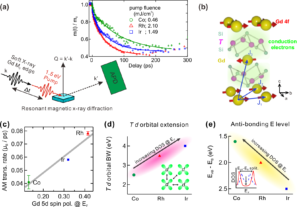
Lanthanide antiferromagnets are of strong interest in materials science due to their exceptionally large 4f magnetic moments leading to potential applications in high-density memory devices. Since the 4f moments are spatially localized, their ordering occurs indirectly by spin-polarizing itinerant conduction electrons via the indirect RKKY exchange interaction. The strength of this RKKY exchange has been directly linked to the ultrafast angular momentum transfer rate between antiferromagnetic sublattices. Despite this progress, the role of the microscopic ingredients to the RKKY interaction (on-site 4f orbital overlap and itinerant spin polarization) remains elusive up to now.
In our preprint, we systematically investigate the influence of itinerant conduction electrons on the RKKY exchange and ultrafast angular momentum transfer in a series of 4f antiferromagnetic intermetallics. By independently modifying the conduction electron density while keeping the 4f occupation constant, we are able to dissect their individual contributions and comprehensively study their impact on the optical manipulation of magnetic order. We employed time-resolved resonant magnetic soft x-ray diffraction (Fig. a) to study the ultrafast long-range magnetic order dynamics in the 4f antiferromagnets GdT2Si2 (with T= Co, Rh, and Ir; Fig. b). Through the substitution of nonmagnetic transition metal ions, we unveil a twofold variation in angular momentum transfer rates (Fig. c). Our first-principles calculations elucidate that this effect stems from the modulation of conduction electron density and spin polarization, arising from a competition of the transition metal orbital wave function properties (d) and energy level alignment (e).